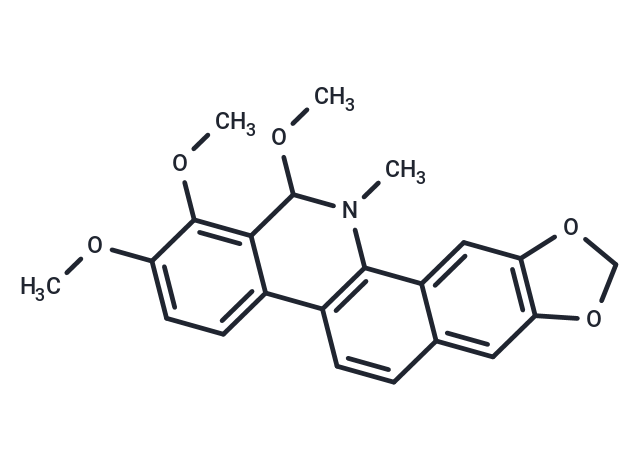Shopping Cart
- Remove All
 Your shopping cart is currently empty
Your shopping cart is currently empty

Angoline (6-Methoxyldihydrochelerythrine) hydrochloride is a potent and selective IL6/STAT3 signaling pathway inhibitor(IC50 : 11.56 μM). It inhibits STAT3 phosphorylation and its target gene expression, and inhibits cancer cell proliferation.

| Pack Size | Price | Availability | Quantity |
|---|---|---|---|
| 1 mg | $60 | In Stock | |
| 5 mg | $147 | In Stock | |
| 10 mg | $217 | In Stock | |
| 25 mg | $363 | In Stock | |
| 50 mg | $538 | In Stock | |
| 100 mg | $779 | In Stock | |
| 1 mL x 10 mM (in DMSO) | $160 | In Stock |
| Description | Angoline (6-Methoxyldihydrochelerythrine) hydrochloride is a potent and selective IL6/STAT3 signaling pathway inhibitor(IC50 : 11.56 μM). It inhibits STAT3 phosphorylation and its target gene expression, and inhibits cancer cell proliferation. |
| Targets&IC50 | IL-6/STAT3 signaling pathway:11.56 μM (IC50) |
| In vitro | Angoline as a potent and selective inhibitor of the STAT3 signaling pathway (IC50=11.56 μM).?Angoline inhibited STAT3 phosphorylation and its target gene expression and consequently induced growth inhibition of human cancer cells with constitutively activated STAT3 (IC50=3.14-4.72 μM).?This work provided a novel lead for the development of anti-cancer agents targeting the STAT3 signaling pathway. |
| Alias | 6-Methoxyldihydrochelerythrine |
| Molecular Weight | 379.41 |
| Formula | C22H21NO5 |
| Cas No. | 21080-31-9 |
| Smiles | COC1N(C)c2c(ccc3cc4OCOc4cc23)-c2ccc(OC)c(OC)c12 |
| Relative Density. | 1.36g/cm3 |
| Storage | keep away from direct sunlight | Powder: -20°C for 3 years | In solvent: -80°C for 1 year | Shipping with blue ice. | ||||||||||||||||||||||||||||||
| Solubility Information | DMSO: 30 mg/ml (79.07 mM) | ||||||||||||||||||||||||||||||
Solution Preparation Table | |||||||||||||||||||||||||||||||
DMSO
| |||||||||||||||||||||||||||||||

Copyright © 2015-2024 TargetMol Chemicals Inc. All Rights Reserved.